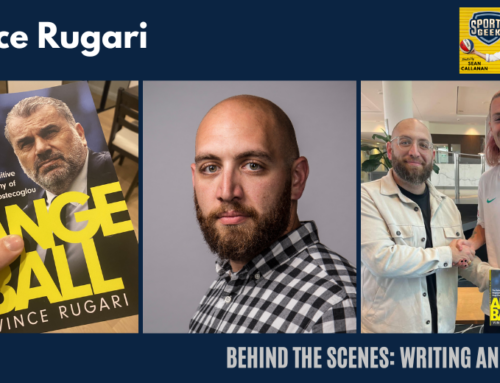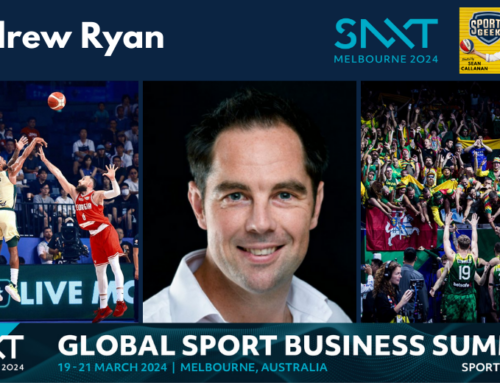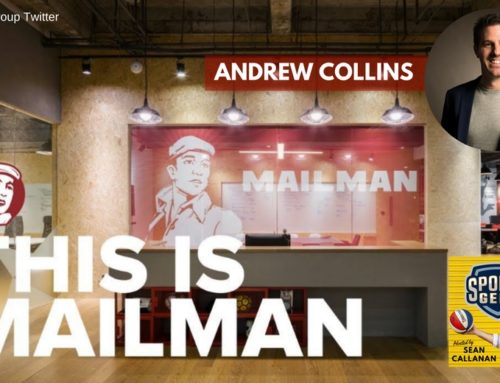In this ABC Grandstand sports digital segment we look at how the changing media is changing sports broadcasting & journalism.
Is media consumption changing sports media?
Media is shortening
Print 800-2000 words > Blog 400-500 words > Facebook – Sentence > Tweet 140 chars > Instagram – Picture only
Social TV allows people to tune in when the game gets interesting rather than watch the whole game.
– NBA alerts fans via Twitter to tune in to League Pass
– NFL has Red Zone alerts when teams are with 20 yards
Where does this leave long form storytelling in broadcasting & journalism?
- telecasts & even sports are being shortened, T20 best example others to follow. 20 minute AFL preseason, harness racing, hockey, soccer all looking at modified games.
- will we see broadcasters like Vin Scully who paint the picture
Bucking the trend – Grantland.com – Led by Bill Simmons pushing long form articles in digital space.
What do you think? How has your consumption of sports changed?
Sports Geek Medals – Stanley Cup edition
 Thanks to Myles Harris from VancouverCanucks.com.au for assisting in awarding the #digisport medals this week. Hope the Canucks fans enjoyed it.
Thanks to Myles Harris from VancouverCanucks.com.au for assisting in awarding the #digisport medals this week. Hope the Canucks fans enjoyed it.Bronze – James van Riemsdyk
James Van Riesmsdyk of the Philly Flyers doing a great job of replying & having fun with fans.
Silver – Bob McKenzie – TSN Hockey Insider
Does a great job as a broadcaster to provide that little bit extra for the fans.
Gold – Trevor Linden
Retired Canucks God according to Myles but provides good perspective on games as a former player.
Until next week
Catch it live on Saturday mornings (at 7:40am) when Sean Callanan discuss sports digital with Francis Leach on ABC Grandstand.
Tune into ABC Grandstand Breakfast over the Friday through Monday on ABC Grandstand digital radio.
Follow @saintfrankly
Follow @abcgrandstand
Get the Sports Geek podcasts
Want to get these clips in podcast form? Subscribe here or Add to iTunes
Podcast transcription
FRANCIS: Francis Leach with you for breakfast here on ABC Grandstand Breakfast. I hope your Saturday morning is shaping up well. Our man Sean Callanan, he’s the guru when it comes to all things digital sports media, and he’s with us again today. He’s got a bit of the sad face on, as a Collingwood fan. He’s an emoticon that would be the sad face.
SEAN: I’m not a big fan of emoticons, but, yes, it would be a sad face, Francis.
FRANCIS: I’ve never seen you tweet an emoticon.
SEAN: I’m not an emoticon guy, but, nah, yeah. I draw the line at emoticons. I’ll leave that for my teenage kids.
FRANCIS: Okay, It’s interesting that the topic you’re bringing up this morning is about how the sport’s media is changing the way we watch sport, particularly because of our access to digital and social media.
SEAN: Well, yes, it is just a little bit, and we were discussing this last week off air, about how our access to so many different sports is changing and we’ve got so many different options and it’s really affecting the way that we consume media.
If we look 20 years ago, we’d watch five days of cricket in summer and watch four games of footy and things like that in winter, but now we’ve got so much. We talk a lot about the premier league in the UK and the NBA, and we’ve got so much more access to those, but also we’re not tuning in for the whole game. So there’s a bit of a phenomenon called social TV, where social media is trying to drive and draw traffic and it’s sort of the ‘look-at-me mentality.’FRANCIS: Is that where Fango comes from?
SEAN: Oh, (sighs in disgust)….
FRANCIS: I know you hate it, but that’s an attempt to do that. Is that really a hand fisted attempt to do that?
SEAN: It’s a little bit of an attempt to do that. It’s sort of to try to trap the conversation is probably a good way of putting it, to sort of have these people talking about it, to keep them engaged with the show. But it was probably more like when the NFL started a little bit earlier with their red zone alerts.
FRANCIS: And how did that work?
SEAN: Well probably because they have so many games happening at the same time and they’ve got all these people playing fantasy football. You know they start with mobile alerts to say, ‘Hey, the quarterback’s within 20 yards of the goal line, so there’s a chance for a touchdown; there’s a chance for a scoring play, tune in.’ So people would flick their TVs across. So it ends up rather than sitting there watching a whole game and having the broadcasters tell the story and talk about the back story and how some guys come from college or he’s coming back from a knee injury, they’re just tuning in for that highlight package at the end.
FRANCIS: Have they been able to track how effective it’s been in switching numbers of eyeballs to tune into games once they’ve been directed and alerted by a social media.
SEAN: Well, the analytics for that is coming up. I mean it’s only still developing but the NBA is doing the same now with, you know, they’re using their Twitter account to point people to League Pass, to say, ‘Hey, guys, there’s a hot game on. Durant and LeBron James are going off, five minutes to go, it’s game on, tune over.
So, one, it’s getting people to tune in and a lot of people want to blame Sports Center for that highlight mentality, but people now are only tuning in for the best parts of the game, whether it’s generated by the leagues or whether it’s generated by fans and their followers. If you’re sitting there, and I know I do it at times, whether it’s sport or other TV shows, if my Twitter feed starts filling up with ‘Hey, you’ve got to watch Media Watch’ or Q & A is going off, and that causes people to tune in. We’ve seen the same thing with sport, so it’s really the way that the media is being condensed. We used to be reading magazines and long form articles and then they become digital articles, so then they become a bit shorter because you’ve got to read them on your mobile, and then they become blog posts so they’re shorter again, then they’re just sentences on Facebook, and then finally they’re just tweets or they’re just Instagram photos.
So they’re becoming shorter and shorter in the way that it’s being consumed and so journalism and the way it’s being presented back to sports fans is changing, as well.
FRANCIS: 1-300-460-644, if you want to join the conversation, 1-300-460-644 is our number. Give us a call if you are somebody who relies on your Twitter account or indeed Facebook or whichever social media you use to direct you to the sport you watch. If you see a flag go up on your phone that says five minutes to go game on do you tune in and is somebody that actually gets involved in letting people know about that stuff, as well, and which sources do you rely on to direct you to the sport that you want to watch, 1-300-460-644, or you can send us a tweet, hashtag #grandstand.
Are we sacrificing quality and analysis for simplicity and instant access?
SEAN: Oh, definitely, you know, the days of Vince Scully, he’s the famous Dodger’s broadcaster, he’s still commentating, and he does it all by himself. He’s talking to the fan the whole way through the game. Yes, gone are the days of those kinds of guys because the broadcasters are under pressure to produce those highlight reels, to produce those tapes. But also the sports are changing. We are seeing it with T20.
The longer form of the game isn’t as appealing from a TV in a digital point of view and so they’re looking for shortened forms of the game. A lot of sports now are even looking at ‘well it’s not just our reporting we’ve got to change the game,’ so go to a shortened form. We’re seeing it with cricket, hockey is experimenting it with less players, bigger nets. Even harness racing is thinking about doing a one lap race, sort of a 20/20 style form for harness racing.FRANCIS: Does the horse have to wear colored clothing?
SEAN: Well, yeah, potentially it would be pajama top racing but you have to train, unfortunately, the horses that can’t say ‘No, I’m just a 20/20 type racer.’
FRANCIS: You can’t be the Chris Gayle of horses.
SEAN: Exactly, you just have to train it at least, so where is it going to end really? It’s a strange one.
FRANCIS: With this, are the sports organizations catching on and trying to own the conversation and is that what we’re seeing here, as well? I mean, are they trying to because sports organizations are extremely mindful of their reputation and their image and are they trying to shy away from the fans taking control of all of this?
SEAN: Yeah, a little bit, but it’s really, it’s just another way for them to serve their TV masters. What they’re seeing is the attention being spread, with one being other sports, the other being gaming. You know 20 years ago people weren’t spending 20, 25 hours a week playing games. Sometimes people want to play as Tiger Woods rather than watch Tiger Woods, so you can play as LeBron James on the Xbox or the Play Station rather than watch him. So they’re competing against other things so it’s a way to keep the price of TV rights going up. The TV, the sports have to work harder at making sure the fans are invested.
FRANCIS: Is anyone backing the trend? Is anyone the vinyl record of this new digital age if you decided that this all well and good, but I prefer old fashioned long form writing and considered analysis with five pages of prose.
SEAN: And, well, it is quite strange that Bill Simmons, Sports Guy 33, who we’ve profiled and go to #digisport medal in the first show. He’s actually taking it completely in the other direction. He set up grantland.com, which is dedicated to long form articles. And so it’s even gone to the point where you can now get those articles in print. You can get the Grantland Quaterly and actually get a book of articles.
FRANCIS: He is the vinyl records of sports reporting.
SEAN: He is, and there is an appetite for it, so it is just a matter of how it is presented. He’s still using all short form scenarios and Facebook and Twitter to tease the audience. There might be ten articles and only the articles that you’re interested in you will invest in, so whether you’re a Knicks fan and you read one about the plight of the Knicks or, you know, if he does an article on the Red Sox you’ll tune in and rate it or you’ll listen to the podcast, so there is a tendency to go there and I think there’ll be a lot of media partners looking at that model and going how can we do it? It’s still effectively a niche, but it’s providing that same thing in a digital offering.
FRANCIS: And in Australia we had the Football Almanac as well, which was put together by John Harms and a bunch of other local writers who write long form, considerate pieces about Australia’s football. They’re doing a cricket one, as well, which is more about a contemplative approach to sports reporting that you can take away and enjoy at any time rather than just getting the instance fix.
SEAN: Yean, exactly, and as more people start using that long form on their iPads and their devices it may become a bit more accepted.
FRANCIS: Okay, what’s on the podium this week in the digital sports world, Sean Callanan?
SEAN: Well, this week we’ve got the NHL. The Stanley Cup is heating up.
FRANCIS: We love the Stanley Cup.
SEAN: And we actually shared a tweet from the LA Kings to everyone in not in Bristish Columbia Canada, ‘You’re welcome,’ after they beat the number one seed, Vancouver Canucks. So thanks to and we actually spoke to Myles Harris of the VancouverCanucks.com.au. He set up a site for Vancouver Canuck fans in Australia, and he’s doing a great job telling people about ice hockey.
We got a couple here from, if you want to be following the Stanley Cup, James Van Riesmsdyk, or JVReemer21 for the Philly Flyers. He is a player that’s doing a good job. From a broadcaster point of view we’ve got TSN Bob McKenzie, who is a bit of a hockey insider, who’ll keep you informed of everything that’s happening in the Stanley Cup, and I have to give the gold because Myles is a big Canucks fan, obviously, to Trevor Linden, Trever_Linden, whose a Canuck’s God who is now retired but is obviously backing for the Canucks and providing that perspective of a player from Twitter.
Get behind the Stanley Cup. It should be exciting. The playoffs have just started.FRANCIS: The biggest trophy in world sports.
SEAN: Oh, one of the best, one of the best, and I’ve been lucky enough to actually have my photo taken with it.
FRANCIS: It’s above your head when you stand up next to it; does it sort of tower over you?
SEAN: Yes, it is a big trophy, and you can’t touch it. No one’s allowed to touch it. You can only touch the trophy if you’ve actually won it, so…
FRANCIS: It’s like Spinal Tap but don’t you touch those guitars. Don’t touch it. Don’t even look at it.
SEAN: It’s a bit that way. I might have to dig in the archives. It was about 15 years ago when the photo was taken, so it’s a much younger version of me but lucky enough to actually have my picture taken with the Stanley Cup.
FRANCIS: Great stuff, again, mate. Where can we follow you on Twitter.
SEAN: @Sportsgeekhq or @SeanCallanan or Sportsgeek.com.au





